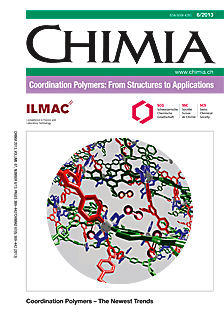Square Grid and Pillared Square Grid Coordination Polymers – Fertile Ground for Crystal Engineering of Structure and Function
DOI:
https://doi.org/10.2533/chimia.2013.372Keywords:
Carbon capture, Coordination polymer, Crystal engineering, Network, PorosityAbstract
Square grid coordination polymers (CPs) based upon four-connected metal centres linked by linear bifunctional ligands such as 4,4'-bipyridine were first reported in 1990 and the study of their pillared variants began in 1995. It was quickly realized by crystal engineers that the modularity of such CPs creates families of related compounds or platforms which in turn affords opportunities for systematic study of structure/function relationships in the context of catalysis, magnetism and porosity. This review covers the historical development of this important class of CPs before addressing recent studies of variants which incorporate 4,4'-bipyridine and related linkers to facilitate control over pore size and inorganic anion pillars to enable strong interactions with polarizable molecules such as CO2. Such pillared CPs offer relatively low cost, high stability and modularity. When these features are coupled with superior performance vs . other classes of porous materials in the context of carbon capture and other gas separations involving CO2, they are likely to gain increased attention in the future.Downloads
Published
2013-06-26
Issue
Section
Scientific Articles
License
Copyright (c) 2013 Swiss Chemical Society

This work is licensed under a Creative Commons Attribution-NonCommercial 4.0 International License.
How to Cite
[1]
S. D. Burd, P. S. Nugent, M. H. Mohameda, S. K. Elsaidia, M. J. Zaworotko, Chimia 2013, 67, 372, DOI: 10.2533/chimia.2013.372.







